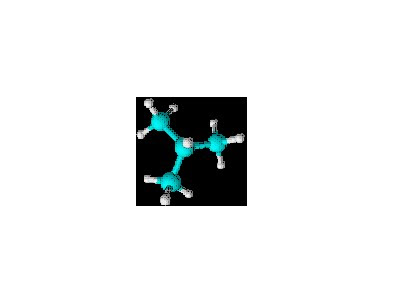Cycloalkanes have molecular formula CnH2n and contain carbon atoms arranged in a ring.That is only true for cycloalkanes with just one ring. Cycloalkanes can have more than one ring, and each additional ring means two fewer hydrogens. And there are a lot of those. Try to keep up, textbook. Anyway, the examples the book then uses for cycloalkanes are all ones with just one ring. In fact, the examples in this section of the book have all of the carbons in the ring, but this is not necessary or even particularly significant.
The smallest cycloalkane ever is cyclopropane, with a molecular formula of C3H8 and a skeletal structure that looks like this...
 Yes, it's a triangle. This really should not surprise you if you've been paying attention, which you haven't. I could show it in 3-D, but so far I haven't figured out a way to post my wonderful 3-D images here in this blog thing without them looking like crap (because I am pasting them into MS Paint and saving them there. If you want pretty pictures, go read a pretty pictures blog or something. I hear that they have those. Such things may be more suited to your intellect.
Yes, it's a triangle. This really should not surprise you if you've been paying attention, which you haven't. I could show it in 3-D, but so far I haven't figured out a way to post my wonderful 3-D images here in this blog thing without them looking like crap (because I am pasting them into MS Paint and saving them there. If you want pretty pictures, go read a pretty pictures blog or something. I hear that they have those. Such things may be more suited to your intellect.Cyclobutane's skeletal structure looks like a square. This should be easy to visualize. Same with cyclopentane and a pentagon. I have already shown the skeletal structure for cyclohexane here and here.
Also, the book claims that the largest known cycloalkane with a single ring has 288 carbon atoms. But this is in a problem asking for molecular formula (and obviously the molecular formula is C288H576) and I cannot tell if it is giving me authentic trivia or merely posing a hypothetical for the purposes of asking such a question and reinforcing the concept.
One last thing, which the book apparently omits in this section (although it will probably come up later) is ring strain. The carbon atoms are most stable at a certain bond angles. In the case of alkanes (and lots of other things, really), the ideal bond angle is 109.5° and all four groups attached to the carbon atom are equally far away from each other, forming a tetrahedron with the carbon atom in the center and each attached group in one of the corners. But when carbon atoms form rings, the bond angles become strained. This ring strain causes the molecule to be more reactive. Cyclopropane, with 60° angles between the carbons, has the most ring strain. After that, it becomes important to note that these rings are three-dimensional objects. They can be denoted with two-dimensional skeletal structures on paper, but are under no obligation to lie flat. So cyclobutane does not actually have 90° angles between its carbons, as "puckering" reduces strain and creates larger angles. Later in the chapter, this is explored for cyclohexane in particular, which has the most stable ring among cycloalkanes.





